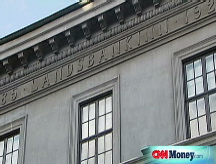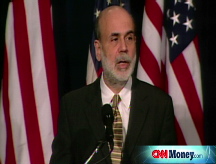Fed's new tool: Business loan bailout
Federal Reserve to buy loans crucial to business to unfreeze markets.
NEW YORK (CNNMoney.com) -- The Federal Reserve announced a new program to help the battered market for short-term business loans - taking its closest step yet to lending directly to businesses.
The program addresses commercial paper, a form of short-term funding crucial to many businesses operations.
"The Treasury believes this facility is necessary to prevent substantial disruptions to the financial markets and the economy and will make a special deposit at the Federal Reserve Bank of New York in support of this facility," the Fed stated.
Commercial paper is sold by major corporations and most of the nation's leading financial institutions. They use the proceeds to fund day-to-day business operations. It is bought primarily by money market fund managers and other institutional investors.
"It's basically the checking accounting for business," said Kevin Giddis, head of fixed-income sales trading and research for investment firm Morgan Keegan. "It is literally how they operate on a day-to-day cash basis. It's their main funding source."
Before the current credit crisis, there was nearly $2 trillion of commercial paper outstanding. It was issued mostly for short terms - never more than nine months - and thus had to be renewed frequently.
For investors, it was considered a very safe investment to purchase and one that could be easily resold.
But since the bankruptcy of Lehman on Sept. 15, many leading buyers of commercial paper have been afraid to play in the market, shifting their investments to safer U.S. Treasurys instead. No one wanted to get caught holding commercial paper for a company or financial institution that suddenly found itself in trouble.
And the seize-up of the market itself was scaring investors. Even companies not facing financial problems are at risk of default on their commercial paper if they are not able secure another round of funding when their current borrowing matures.
The new program comes as the Treasury Department scrambles to put in place a $700 billion bailout of the financial system enacted on Friday. Under that program, the Treasury is expected to purchase troubled assets from banks and financial institutions in an effort to spur more lending.
The Federal Reserve is hoping that Tuesday's announcement will be enough to restore investor confidence in commercial paper, according to Fed officials speaking on background. They said the Fed's willingness to buy should assure investors that companies selling paper will be able to refinance.
But Giddis believes the announcement of the program alone won't be enough.
"I think investors will want to see the mechanism at work first," he said. "I'm not sure the investors are going to come rushing in until they see the Fed actually buying."
But he said that the Fed's program is a necessary step, given the importance of commercial paper to so many companies' continued viability.
"There are no real good moves these days. There are necessary moves," Giddis said. "This is one I would deem necessary."
In the past month, the amount of money outstanding in commercial paper loans has fallen 11% to a seasonally adjusted $1.6 trillion on Oct. 1 from $1.82 trillion on Sept. 10.
The decline in available funding indicates only part of the market's problems, however. Investors have also become unwilling to buy longer-term paper - beyond a week or two - from even companies and financial institutions with top-flight credit ratings.
Federal Reserve officials said that the overwhelming majority of the paper outstanding is coming up for renewal in the next several days and companies needing to use the money could face trouble when they try to renew it.
Fed officials said there is no limit to the amount of commercial paper it could buy. They said that market conditions - and the decisions of investors - will determine the extent to which the government will have to step in.
Many of the details of the program, including when it will be open for business, had not yet been settled as of Tuesday's announcement.
The Fed will buy only top-rated commercial paper, of which there was about $1.3 trillion outstanding in August. About $100 billion of that was in the form of unsecured loans to non-financial firms, and about $600 billion was to financial firms. The other approximately $600 billion is backed by assets at the firms issuing the paper, although that is generally considered unsecured lending as well.
Much of the commercial paper outstanding at the start of the credit crisis is now coming up for renewal. As a result, fears have grown that the market could drop even more sharply without some drastic improvement in the market.
Under the program announced Tuesday morning, the Fed will purchase three-month unsecured and asset-backed commercial paper directly from eligible issuers. The program is slated to expire in April 2009 and will have financial support from taxpayers. But Fed officials said Tuesday they did not know yet how much money Treasury would contribute to the program. ![]()




